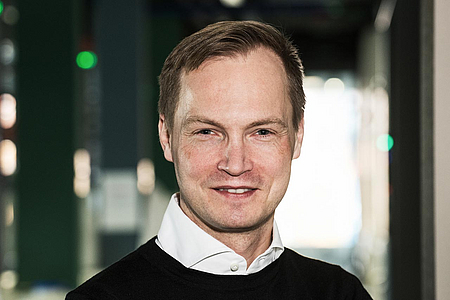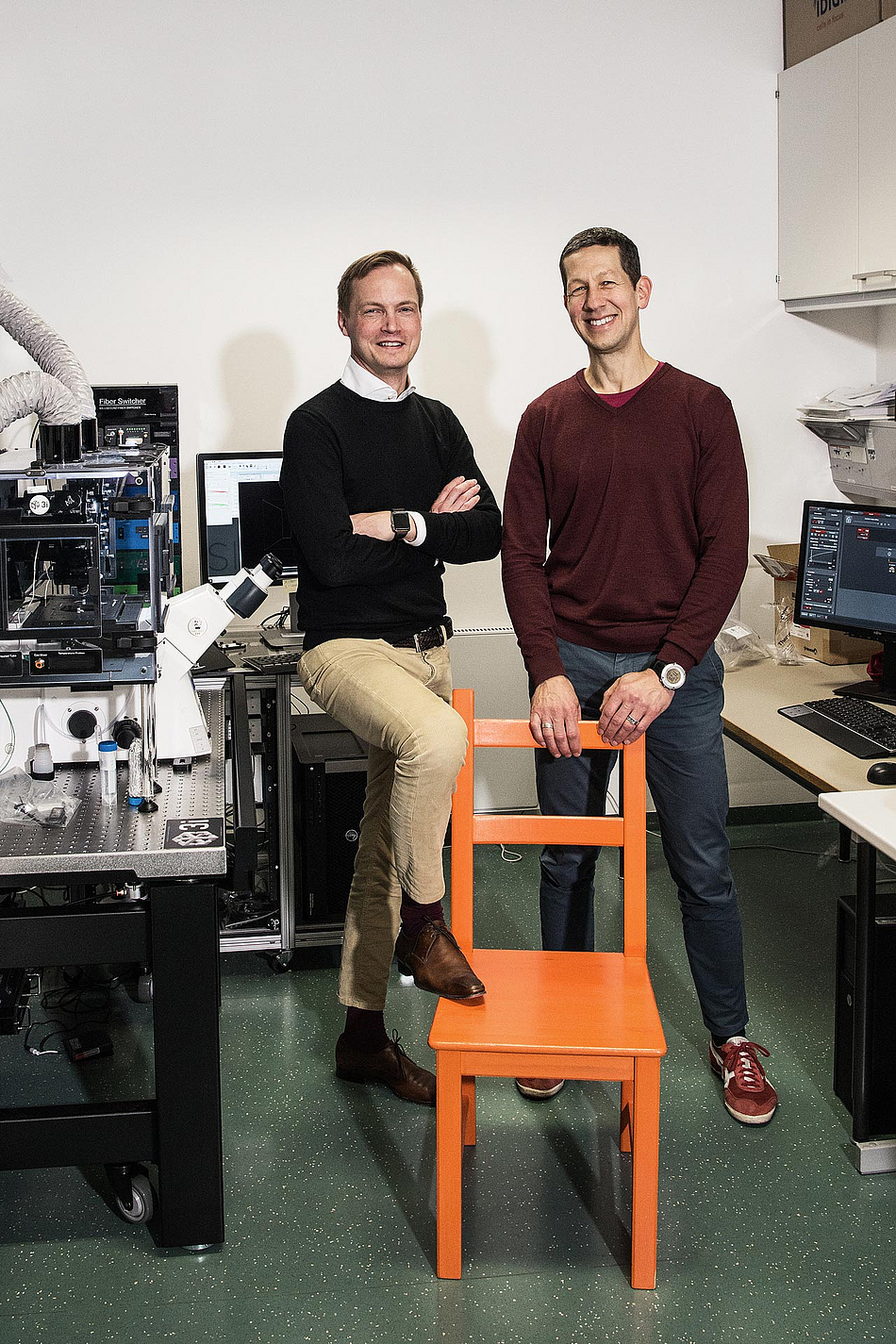The right social contract for an open scientific culture
When BIH Visiting Professor, Michael Potente and his host Professor Holger Gerhardt first met ten years ago, they were each at very different points on their equally different career paths – so it wasn’t necessarily foreseeable that a longstanding, close collaboration would be the result. At our meeting in Berlin, they both explained what makes for fruitful collaboration and why a neuroscientist and a cardiologist complement one another so perfectly in blood vessel research.
You’ve consistently worked on projects together for ten years now. What’s the secret of that collaboration?
Potente: We have a similar concept of what it means to devote your life to science. That’s probably the main reason why our cooperation is so sustainable in the long term, apart from the overlaps in content. We share ideas and concepts at an early stage and don’t regard ourselves as rivals but instead share valuable ideas with one another.
Gerhardt: There are a few scientists with whom that can work, but not many. Science lives from dialogue, but unfortunately competition is often too much in the foreground. From the very beginning, we were able to discuss and critically scrutinize the latest ideas. Our methods were always complementary, so it was rewarding for both sides. Michael Potente studies blood vessels in his research on metabolism, while I focus on the morphogenesis at the cell biology level. This allows each of us to develop new concepts that the other can take up. Up to now, we’ve worked more at the level of basic research, but through this project we’re developing concepts which will be relevant for translation in the near future.
Dr. Potente, you’re a cardiology specialist. How did it happen that you’re primarily doing basic research today?
Potente: Already as a student, the physician scientist was always an ideal in my mind. That idea is what has motivated me in my career. It’s exciting to come into contact with people who take other paths. It helps you to develop further as a person. The clinical career path is predictable and may offer financial incentive – but if that’s your priority, then in my view you’re making a mistake anyway. The decision-making and interaction between people proceed completely differently in medicine and in research. It’s also helpful to be able to change your perspective. As a scientist, you can study things in great depth and go in a direction that isn’t necessarily constructive. That’s when medicine can bring you back to reality.
Gerhardt: There is no real blueprint for scientific careers – what matters here is individuality. We urgently need people with different career paths who connect new fields together.
Do you specifically select the people for your research group in accordance with that idea?

Funding program
BIH Visiting Professors
Funding period
2017 – 2020
Project title
Mechanisms of vessel size regulation – role of YAP/TAZ signaling
Research area
Biophysics
Institution
Max Delbrück Center for Molecular Medicine (MDC)
2004 – 2011
Specialist in Cardiology, University Hospital Frankfurt, Goethe University, Frankfurt, Germany
Since 2012
Group Leader, Max Planck Institute for Heart and Lung Research, Bad Nauheim, Germany
Since 2013
Cardiologist, University Hospital Frankfurt, Goethe University, Frankfurt, Germany
Gerhardt: Science isn’t a planned economy, which is why it’s essential not only to see where the differentness of the individual can represent an asset, but also to assess the risk when you venture into a new area. That’s how, for example, Katie Bentley joined my research group: before that, she had studied robotics and artificial intelligence, and applied computer models – developed to solve logistical problems in urban planning and sociology – to biological questions. However, when you look at the interactions in the cell from a spatial and temporal viewpoint, the questions aren’t all that different. So, at my lab she develops generative computer models to predict how blood vessels will react to a signal pathway and the addition of growth factors. “Generative” means that you don’t precisely stipulate that A and B always lead to C. Instead, you model certain rules, then let the program run and can, during the process, change a few parameters. Through the interactions, new things come into being: we call these “emergent properties”. We already knew from the mouse model and the clinic, that blood vessels react to growth factors in a sensitive and dose-dependent way, but until the development of the computer model, we had no idea why they did that. The model generated a completely new hypothesis that we were then able to test in an experiment, which took five years. This is why it’s important to have funding instruments that have a certain readiness to take risks, are designed for the long term and trust the people behind the research.
Can these findings already be applied in patient care today?
Gerhardt: A non-invasive method for measuring some of our results in the human being still needs to be developed. The growth factor also affects the notch signaling pathway, which determines whether adjoining cells behave as individuals or synchronize themselves.
This has an effect on how blood vessels can develop. If people form a huge cluster at a city train door and all try to get in at the same time, they’ll never get through the door. They have to push and shove one another. If the endothelial cells that form a vessel behave individually, you can make a vessel longer and wider because they can move past one another. We assume that whether or not they push and shove one another depends on the asynchronous or synchronous notch activity of the cells. If there’s too much growth factor there, the vessels are thick and can’t branch out. For example, what’s needed is a nano-antibody that you can display in high resolution in MRT. That would allow us to determine the molecular state of the cells in vascular malformations. If that point on the blood vessel showed a synchronization of the endothelial cells, you could bring them out of that state by influencing the activity of the signaling pathway. You can run through all this on the computer model, but we still don’t have diagnostic instruments to bring our concept to clinical practice.
Potente: The inhibition of certain growth factors is already used at the clinic, for example in cases of breast carcinomas. However, the problem is that in many cases it doesn’t work. So it probably isn’t the best way to prevent blood vessel changes in tumors. Perhaps we have to combat the mechanism in the cells that leads to this state. Translation is important, but you can only develop new, innovative applications by understanding the whole process. To do that, you need the basic research.
How many researchers manage to cross over from basic research to clinical work?
Potente: It depends what you’re working on. The best example is CRISPR-CAS. At first, we didn’t know whether it was medically relevant as it was discovered in bacteria. Today, it may be a game-changer in many areas of medicine. The question is whether one has to cover a whole portfolio as an individual. In any case, due to the complexity of the technologies, we tend to work more in networks – which is why I think the right environment is more important.
But you don’t always meet the right people straight away. Often, knowledge remains limited to a specialist field… Should we be creating more initiatives to make research results available across disciplines?
Gerhardt: At the moment, progress and new discoveries still depend largely on human intellectual activity. Whether making all information available at all times would speed up the process of gaining knowledge hasn’t yet been proved. You could, for example, assume that humanity would be better prepared for complex challenges today, as all information is available at all times via the Internet. However, this doesn’t necessarily seem to be the case. In science, there’s an area of tension between the options of building on available information or making a completely fresh start. Being able to access all information at all times can also be paralyzing. You have to cultivate enough naivety to allow yourself to have new ideas.
Does current scientific culture create that space for new ideas?
Gerhardt: Yes, to some extent, but not yet to a sufficient degree. We need a scientific culture that promotes openness and where people aren’t afraid to share their ideas – in short: where ideas, and not people, predominantly lead the way.
You argue for an open culture among scientists. What’s the situation with openness towards the outside, i.e. society? After all, topics like ethical standards or animal experiments are a subject of heated public debate…
Gerhardt: On the one hand, we scientists do have a duty here, but on the other, so have the big funding institutions. They need to communicate openly what has been made possible through science. For example, it should not only be the scientists who communicate the point and the necessity of animal experiments, but also those who help make political decisions but don’t carry out animal experiments themselves. Nowadays, with Brexit, you wonder why no one ever spoke up about what’s positive about the European Union. That could happen in science too if the relationship of trust between the public and research is lost. To prevent that, we need a social consensus. It’s an intrinsic part of our social contract that tax money is invested in science, in order to gain knowledge and to improve our quality of life – or, in the case of animal experiments, to combat diseases.
Potente: The debate is often conducted in a very ideological way. If you oppose it as an individual, you become a public target. The discussion needs to be brought back to the objective facts. After all, most people want progress in medicine. In order for them to be able to build up the necessary trust in science, they need to see who’s behind the research. To that end, science must be made accessible. As scientists, we should be able to explain our research in a comprehensible way. For me, it’s always a warning sign if I can’t explain what I’m currently working on to my wife – who’s a doctor, even. In that case, I need to rethink my concept one more time.
October 2018 / MM
